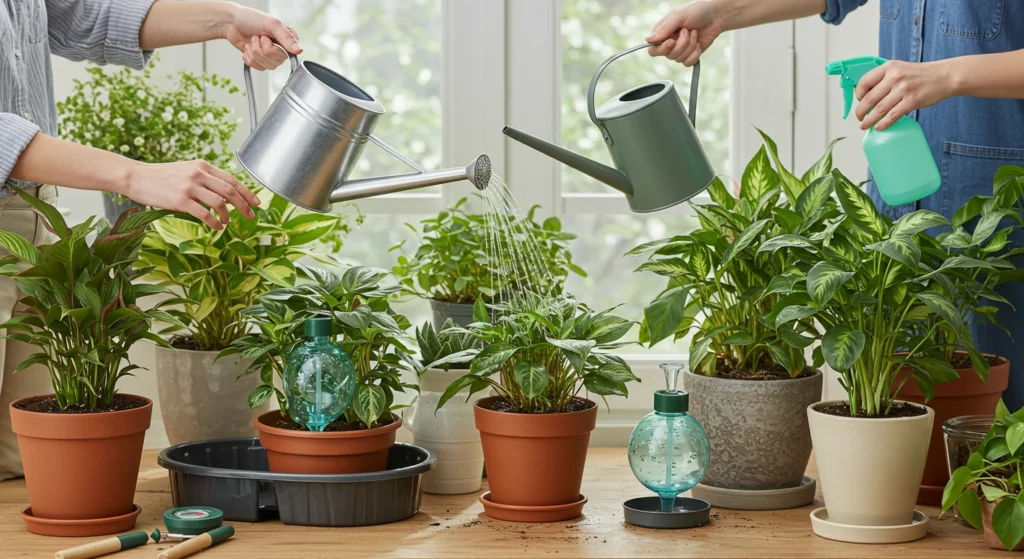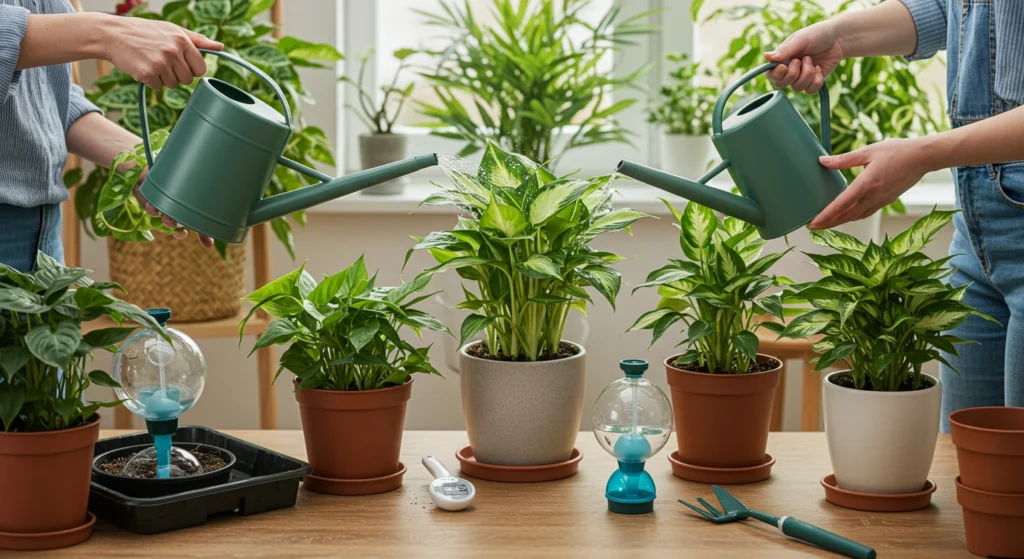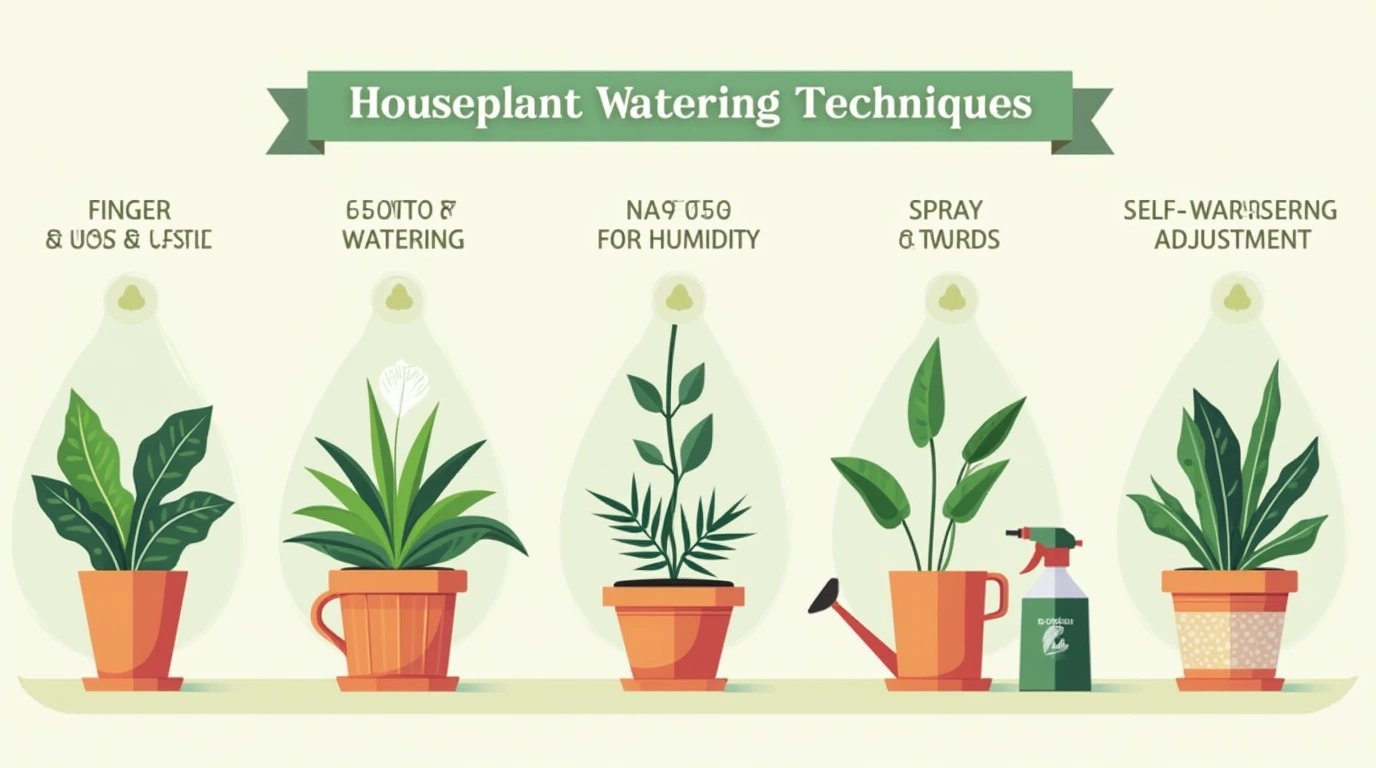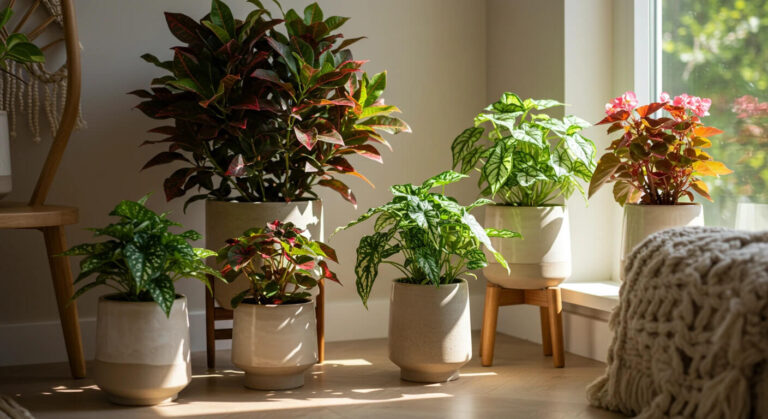Watering Plants: 5 Expert-Approved Ways To Boost Growth
Did you know that nearly 80% of houseplant deaths are due to improper watering techniques? That’s right – most plant parents are unknowingly drowning or dehydrating their green companions! Whether you’re a novice gardener or seasoned plant enthusiast, Watering plants correctly remains the cornerstone of successful gardening. Many plant lovers find themselves struggling with plant watering, unsure if they’re providing too much or too little moisture. This guide will transform your watering routine with five proven techniques that help your plants not just survive, but truly thrive.
Table of Contents
Essential Tools for Watering Plants: Must-Haves for a Thriving Garden
To master the art of plant hydration, you’ll need these fundamental tools in your arsenal:
- Watering can with narrow spout: Directs water precisely to soil, avoiding leaf splash
- Moisture meter: Eliminates guesswork by measuring soil dampness accurately (alternative: wooden skewer)
- Spray bottle: Perfect for misting tropical plants and increasing humidity
- Self-watering globes/stakes: Ideal for vacation periods or forgetful waterers
- Saucer/drainage tray: Collects excess water to prevent root rot
- Distilled or filtered water: Reduces mineral buildup, especially important for sensitive species
Timing Considerations
Understanding when to water is as crucial as how you water. Most indoor plants require:
- Checking frequency: 1-2 times weekly (25% faster plant growth compared to random watering)
- Preparation time: 2-3 minutes per plant for proper assessment
- Total watering session: 15-30 minutes for an average collection of 10 plants
- Seasonal adjustments: Reduce frequency by approximately 30-50% during winter dormancy

Step-by-Step Watering Techniques for Healthier Plants
Properly watering plants is essential for vibrant growth, and using the right method can make all the difference. Here’s a step-by-step guide to effective watering techniques that cater to different plant needs and growing conditions.
Step 1: The Finger Test Method
One of the easiest ways to determine when to water your plants is by using your finger. Insert your index finger about 1–2 inches into the soil. If the soil feels dry at that depth, it’s time to water. This simple technique is ideal for indoor gardening and works because most plant roots are concentrated in the top few inches of soil, the area most affected by drying. This method helps avoid both overwatering and underwatering when watering plants in small or medium containers.
Step 2: Bottom Watering Technique
Bottom watering is a powerful technique, especially for potted plants. To use this method, place your plant pot in a shallow tray with 1–2 inches of water. Let the soil soak water from the bottom for 15–30 minutes. This technique ensures plants take only the amount of water they need and strengthens root systems. When watering plants from the base, you minimize the risk of fungal growth and soil disturbance.
Step 3: The Soak and Dry Method
Mimicking natural rainfall, the soak-and-dry method involves watering your plant thoroughly until water drains from the bottom. Then, allow the soil to dry out before watering again. This is especially important for houseplants like succulents or cacti. By following this method when watering plants, you replicate the natural water cycle, which helps prevent root rot and encourages stronger root development.
Step 4: Misting and Humidity Control
Some tropical species require more than just soil hydration. For these plants, misting is an important supplement to regular watering routines. Lightly mist the leaves to maintain a humidity level of around 40–60%. When watering plants that love humidity, such as ferns and calatheas, misting helps simulate their native tropical environment and keeps their foliage healthy.
Step 5: Seasonal Watering Adjustment
Your plant watering schedule should adjust with the seasons. During spring and summer, active growing periods-increase watering frequency by up to 30%. In fall and winter, when growth slows, reduce watering accordingly. Matching your watering plants routine to seasonal changes ensures your garden thrives year-round and helps prevent common problems like root rot or dehydration.

Choosing the Right Water for Plants
The type of water you use while watering plants plays a critical role in their overall health and growth. Here’s how different water types affect your greenery:
- Tap water: May contain chlorine and fluoride, which can harm sensitive houseplants.
- Filtered water: Removes up to 95% of chemicals but retains essential minerals.
- Rainwater: Often ideal for watering plants, thanks to its natural pH balance (typically 5.5–6.5).
- Room temperature water: Absorbs more efficiently-up to 15% better than cold water.
Healthier Alternatives for Watering Plants
Innovative and sustainable methods for watering plants can improve growth and reduce water waste:
- Rainwater collection systems: Capture naturally mineral-rich water perfect for most plants.
- Fish tank water recycling: Offers nutrient-rich moisture that can boost plant growth by 20%.
- Wicking systems: Deliver steady moisture levels and reduce water usage by 30–50%.
- Greywater irrigation: Safely reuses household water (excluding kitchen sources) for watering outdoor plants.
Application Suggestions
Different plants thrive with specialized watering approaches:
- Succulents & cacti: Allow complete soil drying, then provide deep but infrequent watering
- Tropical foliage plants: Maintain consistent moisture with minimal drying and regular misting
- Flowering plants: Cycle between moderate drying and thorough watering to encourage blooming
- Herbs: Keep consistently moist but never soggy to maximize essential oil production
Common Watering Mistakes to Avoid
- Schedule-based watering: Plants need water based on conditions, not calendar dates
- Overhead watering: Causes 35% higher risk of fungal infections compared to root-zone watering
- Shallow watering: Encourages weak, surface-level roots versus deep, drought-resistant systems
- Ignoring seasonal changes: Plants need approximately half the water in winter compared to summer
- Using cold water: Shocks roots and slows growth by up to 15%
Long-term Watering Strategies
- Group plants with similar needs: Creates microclimate zones that streamline watering routines
- Implement slow-release systems: Water globes or wicking setups maintain consistent moisture
- Mulch indoor pots: Reduces evaporation by up to 70% and extends time between waterings
- Consider pot material: Terracotta dries 25% faster than plastic or glazed ceramic
Conclusion
Mastering the art of watering transforms your relationship with your plants. By implementing these five techniques – finger testing, bottom watering, the soak and dry method, proper misting, and seasonal adjustments – you’ll create the foundation for truly thriving greenery. Remember that each plant has unique needs, and learning to “read” your plants’ responses to different watering approaches is part of the rewarding journey of plant parenthood. Why not start today by assessing your current plant collection and identifying which technique might benefit each one most?
FAQs
Q: How can I tell if I’m overwatering my plants?
A: Look for yellowing leaves, soft stems, moldy soil surface, and a general wilted appearance despite wet soil. Overwatering causes more plant deaths than underwatering.
Q: Is it better to underwater or overwater?
A: If forced to choose, slight underwatering is generally safer. Plants can often recover from drought stress, but root rot from overwatering can be fatal.
Q: Should I water plants differently in winter?
A: Yes, most plants enter a dormant or slower growth phase in winter, requiring 30-50% less water than during active growing seasons.
Q: Does the time of day matter for watering plants?
A: Morning watering (between 6-10 AM) is optimal, allowing plants to absorb moisture before peak transpiration periods and reducing fungal disease risk by 40%.
Q: How do self-watering pots work, and are they good for all plants?
A: Self-watering pots use a reservoir and wicking system to provide consistent moisture. They’re excellent for consistent-moisture lovers but can cause root rot in drought-tolerant species.
Ready to upgrade your outdoor space? Click here to check the latest price on AliExpress and discover why this outdoor storage solution is a favorite for homeowners and garden enthusiasts alike!


